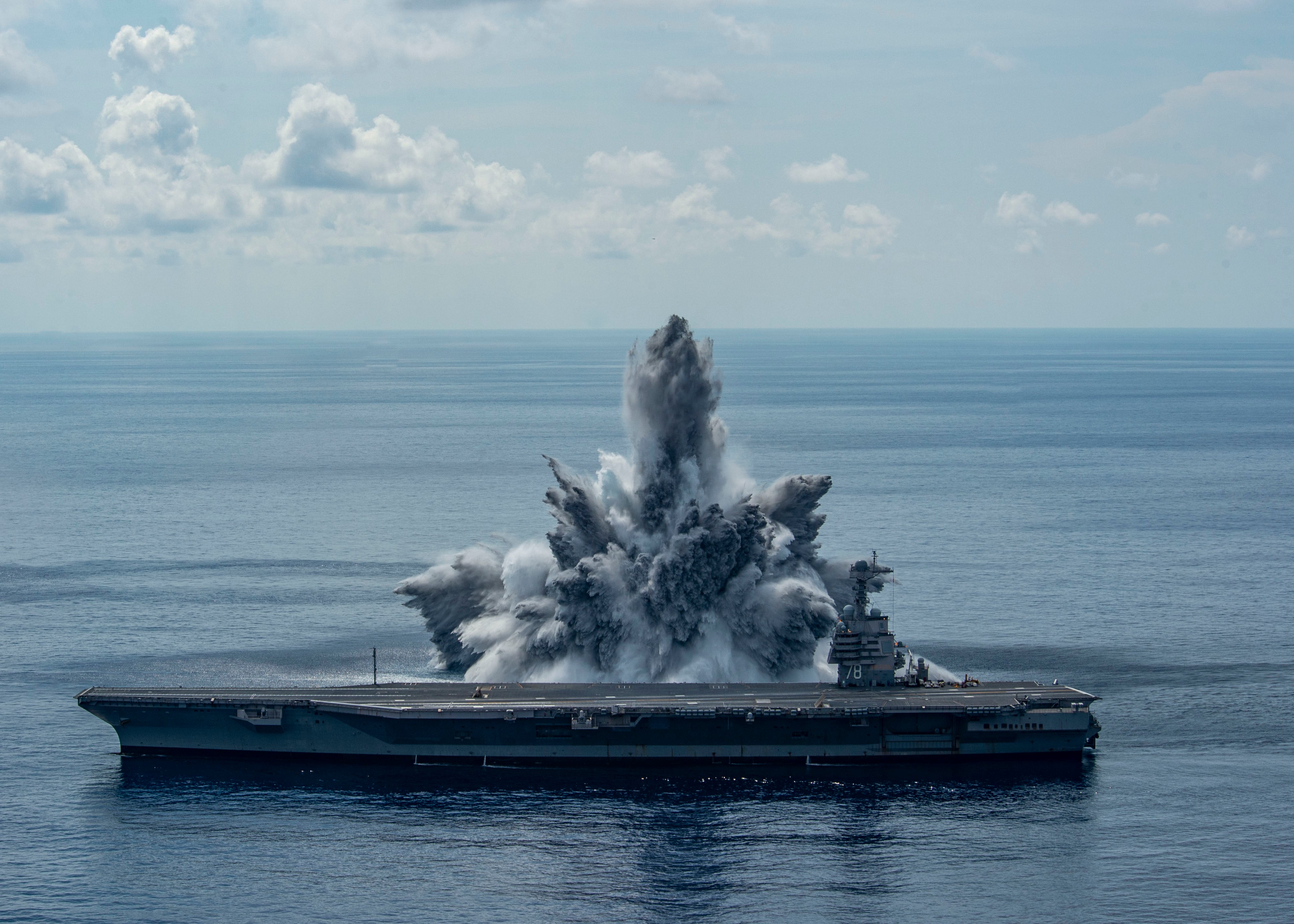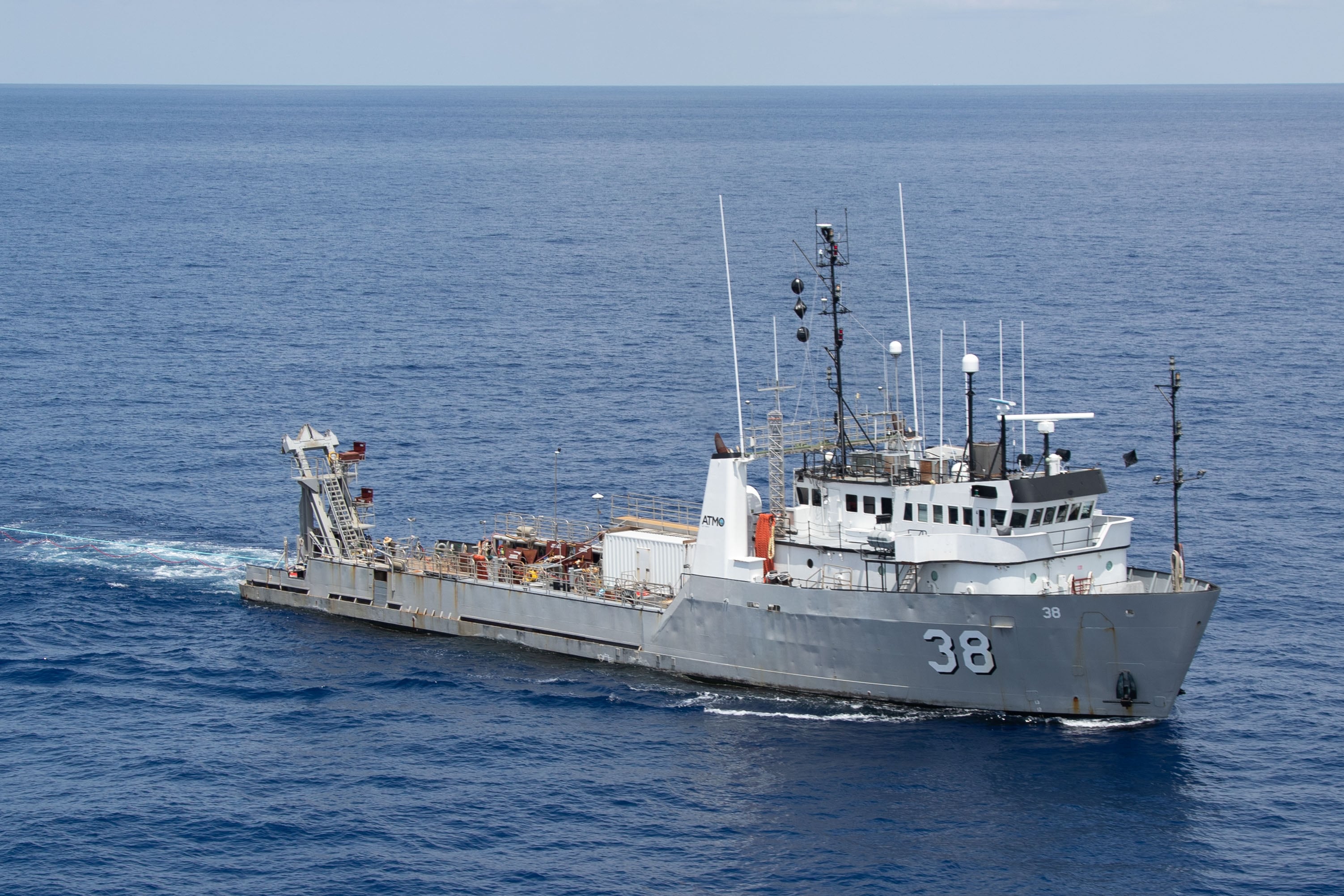WASHINGTON – The U.S. Navy completed its three-part explosive shock trials on aircraft carrier Gerald R. Ford on Aug. 8, with no major casualties on the first-in-class ship and less damage to repair during an upcoming maintenance availability than expected, officials said.
The third blast of the full-ship shock trials, which took place off the coast of St. Augustine Beach, Fla., involved a 40,000-pound charge that exploded “right off the starboard beam” of the new ship. The blast registered as a 3.9 magnitude earthquake — but the ship’s commanding officer said it did less damage than predicted.
Capt. Paul Lanzilotta, who took command of the carrier in February, told reporters in an Aug. 9 phone call there were no fires or floods, no significant injuries and no reports of marine mammal impacts.
“I definitely know that we have added items to our planned incremental availability [maintenance period]; however, we actually plan for that, and nothing that I’ve seen reported to me so far is in the category of so much more work that it’s expected to add to the scope of the availability in terms of schedule,” he said.
“We did have some things break, and we will fix them,” Lanzilotta added.
Rear Adm. Jim Downey, the program executive officer for aircraft carriers, said the Navy originally predicted more work would be required following the string of live blasts and that the maintenance period at Newport News Shipbuilding would take longer. Those predictions were based on what happened during the last carrier shock trial, in 1987 involving the Nimitz-class carrier Theodore Roosevelt.
Upon closer review, though, Downey said the projections for required work were reduced by about 50 percent in 2019, and after the second blast on July 16 the carrier was improving on those revised projections. It will still take a few days to fully inspect and stress the carrier, but Downey told reporters “we appear to be well within the projected scope” of the maintenance period.

He added that most of the items on the ship that broke were not items required to be shock hardened — though Downey and Lanzilotta didn’t provide a list of those items. Typically, hull and combat systems are shock hardened, while items related to office and living spaces aren’t.
Downey noted that only about 5 percent of the work completed during the upcoming maintenance period will be related to fixing items that broke during shock trials; the rest will be modernizing the ship to get it ready for high-end operations during its maiden deployment, anticipated in late 2022.
During shock trials, a small boat tows a 40,000-pound explosive behind it in the water. The Navy has marine mammal search teams ensuring that, though the times and locations of shock trials are planned around known migration patterns, no protected animals are in the vicinity. Once the go has been given, the blast detonates — farther from the ship during the first event, and then successively closer each time — and the crew of about 3,000 braces for impact. After the blast, the crew conducts damage control, looking for any signs of floods or fires and checking combat and ship systems to ensure anything that went offline is quickly restored.
Lanzilotta said helicopters were landing on the carrier within minutes of the blast, showing that the ship was still in fighting condition.
From here, he said, the crew will spend the next few days carefully examining systems and subsystems to ensure it has caught all the damage and then will put the ship through its paces to ensure nothing else pops up when the carrier zooms back towards Virginia at 40 knots.
“Sometimes we can take damage and not notice it immediately because it’s kind of something that’s latent,” Lanzilotta said.
“So we’ll be doing the full high-speed runs here within a couple of days, but in the meantime we’re going inch by inch, stem to stern on the ship to make sure that we’ve inspected her properly and don’t aggravate anything that the giant bomb, that charge that was off the side of the ship, did yesterday,” he added.

Once the ship wraps up these final assessments, it will go to the Newport News Shipbuilding yard in Virginia, just up the road from the carrier’s homeport at Naval Station Norfolk, for several months of work. Once the ship is out, planned for the spring, the carrier’s crew will begin basic training and prepare to come together with the carrier strike group and carrier air wing to train for the ship’s maiden deployment.
Downey said the ship has thousands of sensors onboard to help the crew monitor system health, and thousands more were added for the shock trials to measure how the ship moved when exposed to the detonation. That data will all be compared to the computer model that told the Navy how the ship was supposed to handle the blast — and the ability to validate or update the model will help PEO Carriers going forward as it builds out the rest of the class and looks at potential updates to make the hull and the systems onboard even more survivable in combat.
“We’ll go through that data over the coming months, system by system, mission area by mission area, and look to see if there’s any near- to mid-term adjustments. Right now, at the initial point, we don’t see any larger class adjustments,” Downey said, adding that even some of the higher-risk systems such as the dual-band radar held up well to the shock trial.
Megan Eckstein is the naval warfare reporter at Defense News. She has covered military news since 2009, with a focus on U.S. Navy and Marine Corps operations, acquisition programs and budgets. She has reported from four geographic fleets and is happiest when she’s filing stories from a ship. Megan is a University of Maryland alumna.
